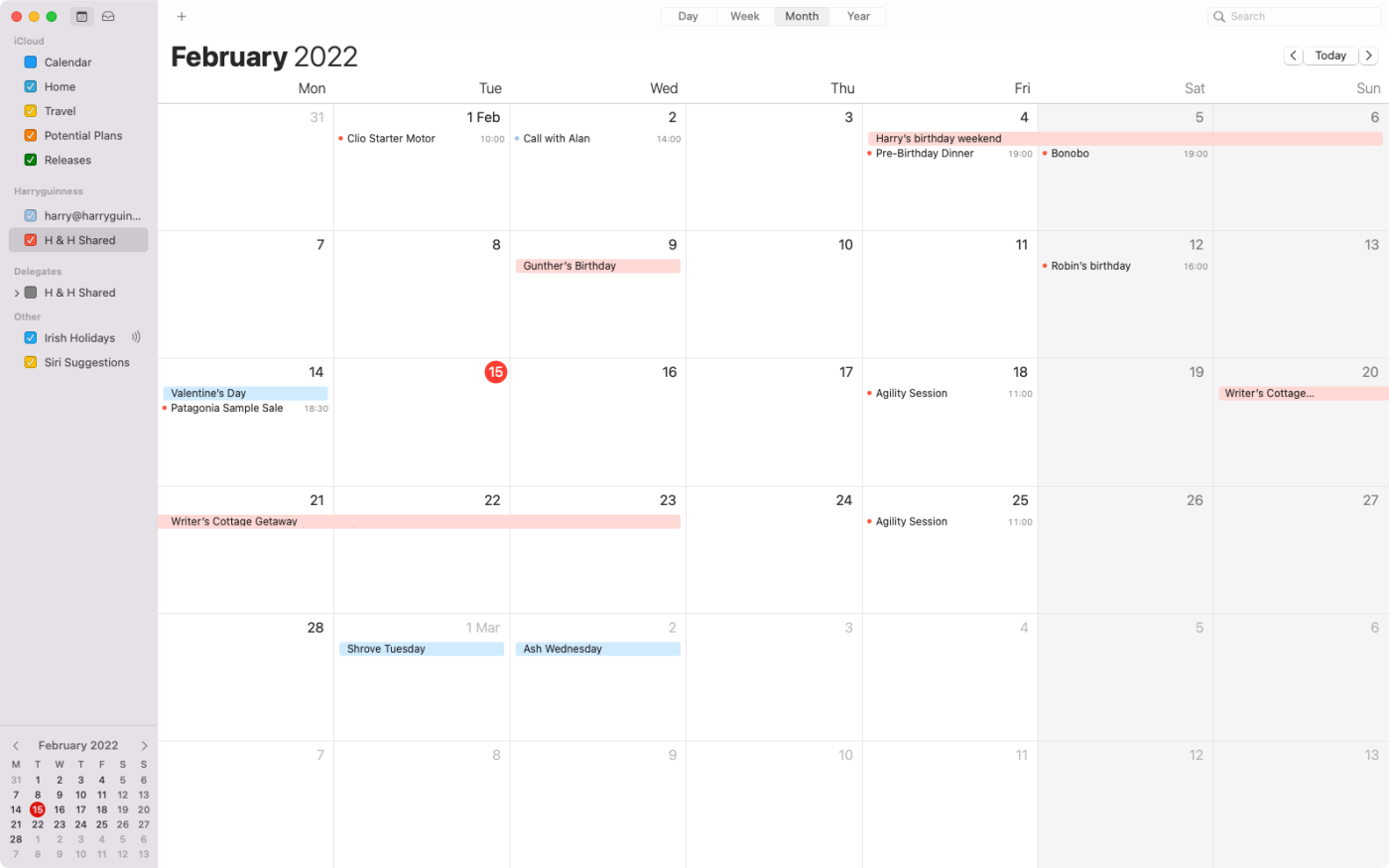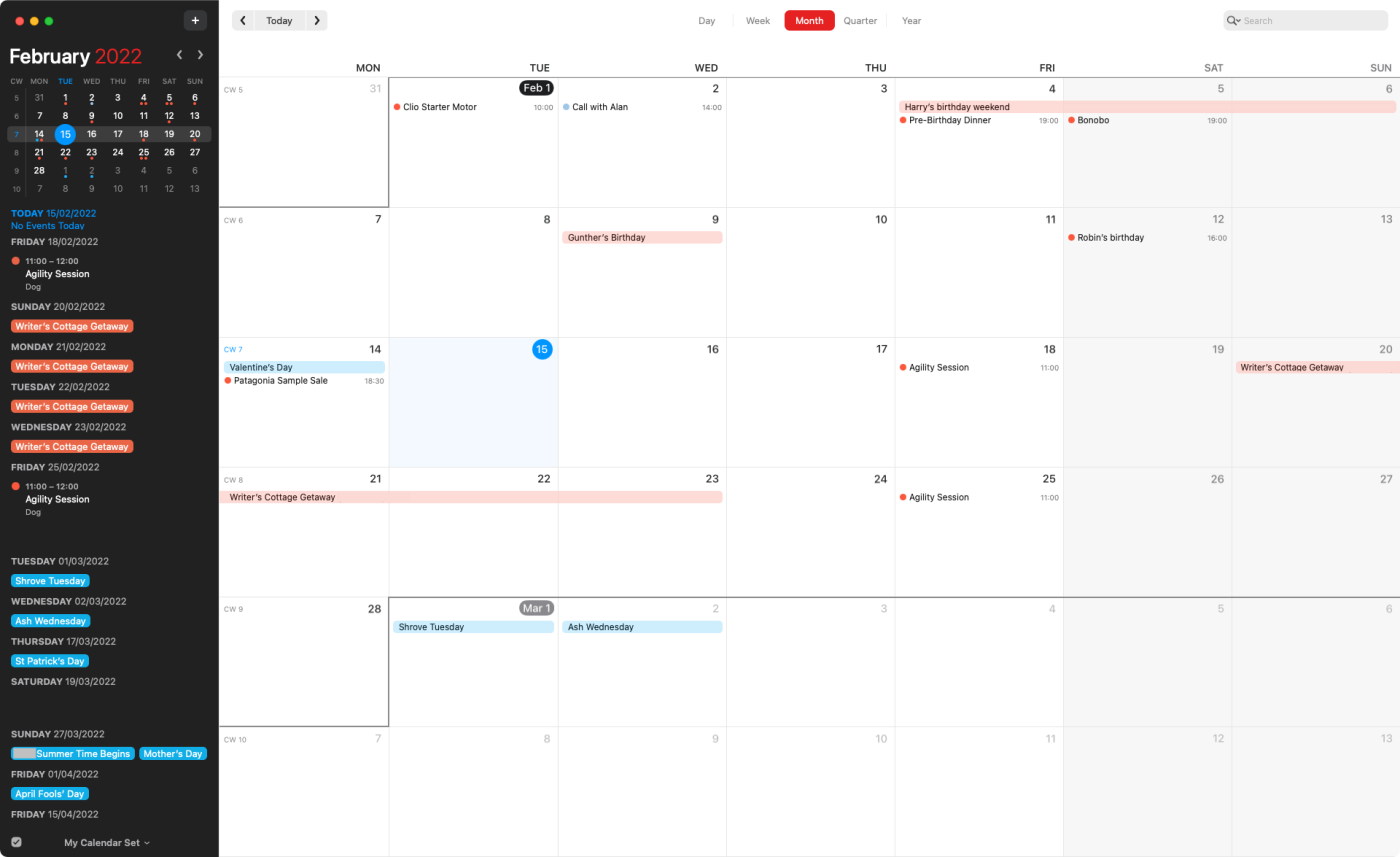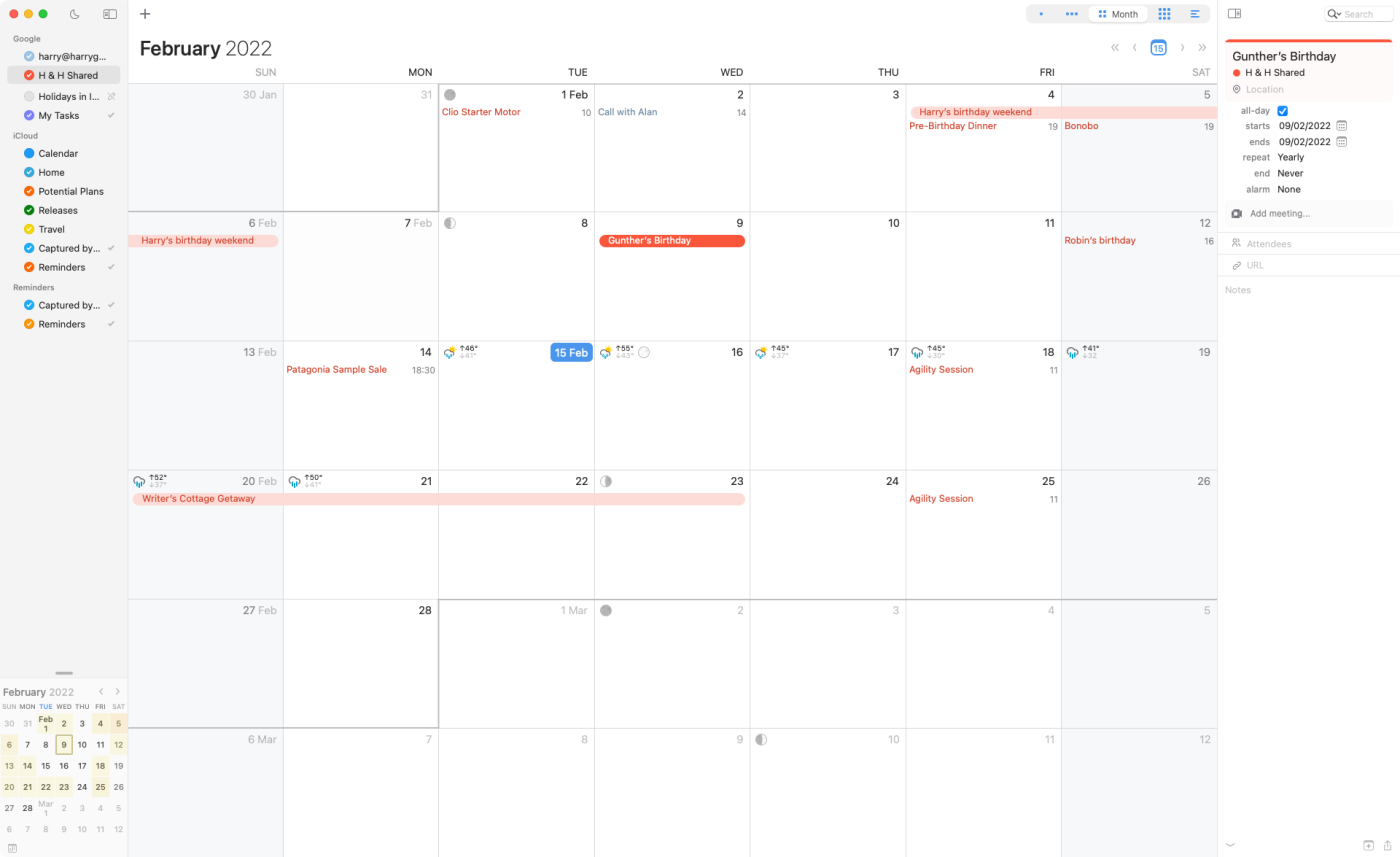The wrong calendar app is worse than no calendar app at all, which is why finding a native Mac calendar app is so important. Inconsistent keyboard shortcuts, notifications, and user interfaces take away from the joy and ease of using an otherwise well-designed operating system.
Bring context to your calendar by connecting other apps
A calendar plays a really important role in keeping my life organized, and as a long-time Mac expert, I have pretty strong opinions on how apps should play nice with Apple’s design philosophies.
I wasn’t looking for the best calendar app (we’ve already done that)—I was looking for the best Mac calendar app. To find it, I tried all the top Mac desktop calendars. These were my five favorites.
The 5 best calendar apps for Mac
What makes the best calendar app for Mac?
How we evaluate and test apps
All of our best apps roundups are written by humans who’ve spent much of their careers using, testing, and writing about software. We spend dozens of hours researching and testing apps, using each app as it’s intended to be used and evaluating it against the criteria we set for the category. We’re never paid for placement in our articles from any app or for links to any site—we value the trust readers put in us to offer authentic evaluations of the categories and apps we review. For more details on our process, read the full rundown of how we select apps to feature on the Zapier blog.
Let me start with this: there’s no Google Calendar app for Mac. But any of the apps on this list sync with Google Calendar to bring you the best of both worlds.
In addition to that requirement, the best calendar apps for Mac all have a few key characteristics:
-
Offer a clean, native user macOS interface. This means following Apple’s design language and integrating well with macOS by offering native keyboard shortcuts, notifications, menu bar icons, and even features like Today widgets. The ideal app, like macOS, is easy to use at a glance, but not in a way that compromises on functionality.
-
Make it quick to add appointments. Speed is everything when it comes to a calendar. If you can’t add events in a few seconds, you’re much less likely to keep it updated. Ideally, you only need to click one button or use a keyboard shortcut to start typing and add an appointment. Natural language processing, which allows you to add appointments by typing something like “Drop off dog at the vet Monday at 5pm,” is a big plus here.
-
Make it quick to see your appointments at a glance. Calendars are only useful if you can actually see what you have coming up, so the ideal calendar app needs to be easy to arrange however you prefer. Daily, weekly, monthly, and agenda views should all be offered, and they should all be easy to parse.
-
Offer syncing, both to mobile and other computers. It doesn’t matter if this is via iCloud, Google Calendar, Exchange, or some combination of those three—some sort of syncing is a must. Your calendar should be available everywhere at all times—that’s the point of using an app.
Apps that can’t do these things weren’t considered, but the best apps offer even more. Also, with one or two exceptions, I only looked at pure calendar apps. Lots of to-do apps, email apps, and other types of productivity apps have some kind of calendar functionality, but it’s not quite the same as being a dedicated calendar app.
To test all the apps that potentially met the criteria, I connected my personal calendars and used them over the course of a week to get a feel for how they worked on a daily basis. (There were a lot of date icons in my Mac’s menu bar for a few days.) Since I’ve been writing about productivity for almost a decade, I was already familiar with most of the apps, but I made sure to evaluate how they’d changed with recent updates to macOS.
Here they are—hopefully one of them is right for you.
Best free calendar app for Apple users
Apple Calendar (macOS, iPhone, iPad)

Not sure where to start? Apple’s Calendar, which is already installed on your Mac, is clean, functional, and syncs with your iPhone and iPad without any effort.
Adding appointments is simple: click the + button. Natural language processing means you can type something like “go for a walk at noon” and expect your computer to figure out what you mean. You can also click-and-drag on the calendar itself to create an appointment. There are four main views: day, week, month, and year.
You can create as many local calendars as you want, and all of them will sync using iCloud. You can also add calendars from Exchange, Google, Yahoo, or AOL accounts. This is handy if you’ve got a work account and personal calendars to keep balanced, and also makes it easier to use shared calendars.
Apple’s Calendar used to offer a to-do list, but tasks now live in Reminders, a separate app. If you want to see tasks alongside your appointments, this app won’t cut it. But there are plenty of other integrations. Addresses, for example, show up in Apple Maps, and you can optionally get travel time notifications. There’s even a Siri Suggestions calendar that pulls in potential events from iMessage, Mail, and other Apple apps.
Apple’s Calendar is simple, sometimes to a fault, but if you only use Apple products, you should try it before installing anything else because it covers all the calendar basics.
Apple Calendar for macOS price: Included with all Macs, iPhones, and iPads.
The best-designed calendar app for Mac
Fantastical (macOS, iPhone, iPad)

Including the word “Fantastic” in the name of your product is risky. Making the name of your product a pun is even riskier. Fantastical pulls off both.
Put simply, this is the best-designed calendar app for macOS, and I am completely biased—I’ve been using Fantastical for years.
Start with the left panel: most apps put a mostly useless list of calendars here. Not Fantastical. Here, that space is used for an agenda view or your reminders. It’s a small thing, but I use it almost every day, and it reflects how carefully the developers thought about every design element to make the calendar intuitive to use. Another little thing: if an identical event shows up in two calendars, it will only show up once, with a pin-stripe pattern letting you know it’s in two different calendars. Use Fantastical for a while, and you’ll notice all kinds of little things like this.
Adding appointments is quick: just hit the plus button and start typing. There’s natural language processing with animated real-time feedback, making it very clear how the natural language processing works. Viewing appointments is also great: there are daily, weekly, monthly, quarterly, and annual views, all well thought out. There’s also a great menu bar icon, which basically gives you access to the left panel in the main interface at any time. Native notifications and a really great Today widget round out the integrations.
Fantastical supports syncing with iCloud, Exchange, Office 365, Google, Yahoo, Fruux, Meetup, and any CalDAV service, so you’ve got nearly endless syncing options. The only downside I can think of is the price, which is high.
The free version of Fantastical offers enough for most people, though it lacks a few features like travel time estimates, support for invitees, and automatic conference call detection that you’d kind of expect an app of this caliber to have. The $4.99/month Flexibits Premium subscription adds all of them, as well as Calendly-style scheduling, and a few other nice-to-have features. Really, the price is the only downside to Fantastical, but it might be worth it for you if you spend a lot of time in your calendar.
Fantastical for macOS price: $4.99/month
The most flexible calendar for Mac
BusyCal (macOS, iPhone)

BusyCal, at first glance, looks almost identical to Apple’s Calendar. It isn’t.
Look close and you’ll see a few things. A weather forecast and moon phases show up in the weekly and monthly views, for example. And there’s more. The right panel can show your to-do list—tasks are pulled in from Reminders. If you don’t use Reminders, this panel can show details from the currently selected event. Or, if you want both Reminders and details, you can have one atop the other. Your Reminders can also optionally show up in the calendar itself, on the dates that they’re due.
Which is just to say that everything about this program is very flexible. Dig through the preferences and you’ll find ways to change the color scheme, what shows up in the info panel, and even customize the fonts. You can add a second timezone to the side panel, which is great if you happen to travel a lot or work with teammates in another area. You can show an alternate calendar, so you can see Hebrew, Islamic, or Chinese dates alongside the Gregorian ones. There’s an availability panel, which is useful if you want to quickly find the next available open spot in your schedule. There’s also a great menu bar icon for quickly browsing appointments. Dig in, and I’m sure you’ll find even more things to tweak.
Adding tasks is quick: just use the + button to use the natural language processing, or click-and-drag the time you want to allot. And there are five main views for seeing your appointments: daily, weekly, monthly, annual, and list. Syncing is handled using the default calendars and iCloud, or you can add accounts from Google, Yahoo, Fruux, Fastmail, Office 365, CalDAV, and Exchange.
It’s a lot of flexibility. The only downside, as with Fantastical, is the price point, but again this just might be worth it for you if you’re looking for the most customizable calendar for Mac or want to avoid subscription pricing.
BusyCal for macOS price: $49.99 with a 30-day free trial. BusyCal is also available on SetApp, a $9.99/month subscription offering dozens of indie Mac apps. BusyCal for iPhone costs $4.99.
Best Mac calendar for Microsoft Office fans and syncing with Windows and Android
Microsoft Outlook (macOS, Windows, Android, iPhone, iPad)

Mac applications tend to focus on doing one thing well, which is why Apple computers come with separate email, contact, to-do, notes, and calendar applications. Microsoft’s Outlook does not adhere to this philosophy—it’s all those things, and more, all at once. If that’s what you’re looking for, then Outlook might be just right for you.
There are four main views to see your appointments: daily, work week, week, and month. The work week view, which isn’t offered by any other tool outlined here, is a good example of how work-focused Outlook is. There are some other nice features: a three-day forecast in the toolbar, for example. Collaboration is a key focus, and the integration with email and contacts helps with that. You can also create templates for appointments, which is useful if you regularly invite people to similar things. Exchange accounts are supported, obviously—Microsoft built the Exchange protocol around Outlook. But the most recent versions of Outlook for macOS also support Google Calendar, which was missing as recently as Office 2016. This is a very welcome addition.
Adding appointments is a little more complicated than other applications we’ve outlined here: there’s no smart entry, for example, which is disappointing. Appointments are created in their own window, but you can still create an event pretty quickly using the tab key.
Outlook might not be the first app you think of using for a macOS calendar, but it’s worth checking out, especially if you’re already a paying Office user. It doesn’t feel as Apple-y as the other apps on this list, and doesn’t offer macOS-specific features like Today widgets, but it does everything you need a calendar to do.
Outlook also integrates with Zapier directly, so you can do things like create Trello cards or Todoist tasks from new events.
Microsoft Outlook price: Starting at $6.99/month as part of Microsoft 365 Personal or $5/user/month as part of Microsoft 365 Business Basic.
The best menu bar icon for Apple’s Calendar
Calendar 366 II (macOS, iPhone, iPad)

Calendar 366 II is a surprisingly complete menu bar calendar. You can basically manage your calendar using only this app, even though it functions primarily as a supplement to Apple’s Calendar, which it uses for all data.
You can open the calendar by clicking the menu bar icon or by using a global keyboard shortcut. Adding tasks is quick, thanks to natural language processing, and you can view your appointments in a variety of ways. The default puts an agenda view below a monthly calendar, but there are other views offered: year, month, agenda, week, week with agenda, and even the current day.
And everything about the application is customizable. There are numerous color schemes, for example, and you can change up the font and layout to your liking. The menu bar item can be an icon or replace your system clock.
It’s great as a supplement to Apple’s Calendar, but it could also replace it completely depending on your workflow.
Calendar 366 II for macOS price: $14.99 (with a 30-day free trial). Calendar 366 for iPhone and iPad costs $6.99.
If you just want a calendar in your menu bar for quickly glancing at but don’t care about all the extra features, Itsycal is a great free option.
Other Mac calendar options
Do none of the apps above hit the spot? Here are a few other options that didn’t quite fit our criteria:
How to automate your calendar
Regular readers of Zapier’s blog will know that we normally highlight a few ways different apps can be automated. What’s unusual with our picks today is that, while only Outlook can be automated directly using Zapier, they all work with calendars that can be automated.
For example, every one of our top picks can sync with Google Calendar. This means you can automate pretty much anything you want. For example, you can create an event in Fantastical for your Google Calendar and have Zapier create Trello cards or Toggl time entries automatically.
Similarly, just because you use the built-in macOS Calendar app, doesn’t mean you can’t use Zapier to create a list of your next day’s meetings (so long as you’re syncing things through a Google Calendar). Remember: all these apps are Mac-native frontends for a variety of different calendar backends.
This article was originally published in April 2019 by Justin Pot.
[adsanity_group align=’alignnone’ num_ads=1 num_columns=1 group_ids=’15192′]
Need Any Technology Assistance? Call Pursho @ 0731-6725516




